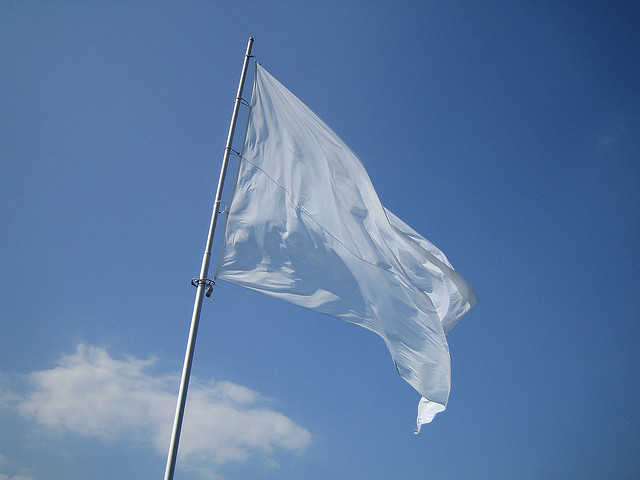Asian gazing (7): the China choice
Posted By Graeme Dobell on June 12, 2013 @ 12:30
 [1]
[1]If Australia’s 2009 Defence White Paper was a red rag to China, then the 2013 White Paper looks more like the white flag of surrender. Trust a journalist to thrust that wonderful juxtaposition of colour and contrasting choice at the Defence Minister, Stephen Smith. Take a bow William Choong [2], formerly hacking for The Straits Times, now wonking for IISS.
The only other question at Shangri La that came close was the Reuters hack who asked the US Defense Secretary, ‘Does North Korea have a right to exist’? If only Asia’s leaders could come up with answers as sharp as the best questions.
The red-rag-versus-white-flag image expresses in sharp terms the tensions and choices tearing at Australia and the rest of Asia in trying to answer the big questions posed by China. On that red rag claim, see John Garnaut’s view [3] that the 2009 White Paper ‘exploded like a bomb beneath the China relationship’and his judgement [4] that after Canberra’s frank assessment of Chinese military growth, ‘bilateral relations plunged to the lowest point since the Tiananmen massacres of 1989’.
So Stephen Smith knew he was kicking against the wind when tried to give the boot to the red rag proposition [5]:
When the 2013 White Paper was released a few weeks ago, I said at the press conference with the Australian Prime Minister where it was launched that I accepted that I was in a minority of one so far as Australian commentators and international commentators were concerned, that the 2009 Australian White Paper was not directed at China. My own view has always been that it wasn’t directed at China. Like any White Paper, it was the mapping out of a strategic document. But I conceded that I was the only person in that camp because one in public life, in politics and in international relations and diplomacy, is often defeated by perception, albeit erroneously placed or not.
The British Defence Secretary, sharing the stage with Smith, offered the consolation that Margaret Thatcher was ‘happy to be in a minority of one, provided she was right!’ The thin grin Smith gave to that solace suggested that he had his own female Prime Minister to worry about.
The true consolation for Smith is that he’s part of Asia’s large cohort of politicians and policy makers who are all grappling with the same challenge: how to handle China without engagement shading towards surrender? An Indonesian friend joked to me that the new White Paper showed that all the ASEAN pills are obviously starting to work on Australia. Canberra, he observed, was eschewing tough-toned Oz speak to adopt an appropriate ASEAN-like caution in straining not to provoke Beijing.
The growing tension between East Asia’s security concerns and economic interests is becoming such a constant of regional journalism it’s trending beyond the standard narrative towards cliché. The fine Financial Times hack Gideon Rachman last week had an example of the genre [6] (requires registration) from Seoul, arguing that South Korea is being drawn out of the US sphere:
Economic forces are gradually pulling South Korea into China’s orbit. The Chinese market is now easily the most important for Korean companies and there are some 200 direct flights a day between South Korea and mainland China. Opinion polls conducted by the Asan institute show that South Koreans have more positive feelings towards the US than towards China—but that most expect China to be the world’s dominant power within 10 years. South Korean anxiety about the staying power of the US is reflected in a domestic debate about whether the country needs to develop its own nuclear weapons to deter North Korea, rather than relying on a nuclear umbrella, extended across the Pacific by the US. Like many countries in east Asia, South Korea now finds its economic and strategic interests pointing in different directions. Economically, it is increasingly part of the Sinosphere. Strategically, it is part of the American-led world. How that tension plays out will do a lot to determine the balance of power between the US and China.
The argument sounds familiar because everybody else engaged in strategic star-gazing in Asia is staring at the same planetary alignment. That knocking sound coming from the Chinese growth engine merely underlines how closely coupled all of Asia’s carriages are to the Sino locomotive. But one thing worse than being drawn ever-deeper into China’s orbit would be for China to cease exerting as much economic magnetism because its growth starts to stutter. For the present, though, it’s still a matter of trying to find a calm space midway between waving red rags and running up the surrender flag.
Asia’s dilemma prompted the French Defence Minister, Jean-Yves Le Drian, to repeat the line he used at last year’s Shangri La dialogue [7], quoting the philosopher, Raymond Aron, who described the Cold War as an ‘era of unlikely war and impossible peace’. The quote mattered now, Le Drian concluded this year, because ‘wars and crises do remain a possibility, in Asia maybe more than elsewhere’. To rework the Aron quote, Asia today faces an era where war is unlikely, but its possibility shadows a time of affluent peace.
Graeme Dobell is the ASPI journalist fellow. Image courtesy of Flickr user PORTOBESENO [8].
Article printed from The Strategist: https://www.aspistrategist.org.au
URL to article: https://www.aspistrategist.org.au/asian-gazing-7-the-china-choice/
URLs in this post:
[1] Image: http://www.aspistrategist.org.au/wp-content/uploads/2013/06/2673925463_f59548992d_z.jpg
[2] William Choong: http://www.iiss.org/en/persons/william-s-choong
[3] John Garnaut’s view: http://www.smh.com.au/opinion/politics/softer-tone-but-china-wariness-remains-20130503-2iyhx.html
[4] his judgement: http://www.smh.com.au/world/chinese-whispers-20130607-2nw3a.html
[5] give the boot to the red rag proposition: http://www.iiss.org/en/events/shangri%20la%20dialogue/archive/shangri-la-dialogue-2013-c890/third-plenary-session-51af/qa-7986
[6] example of the genre: http://www.ft.com/intl/cms/s/0/a408ef8a-cdd1-11e2-a13e-00144feab7de.html#axzz2Vte3kxBC
[7] repeat the line he used at last year’s Shangri La dialogue: http://www.iiss.org/en/events/shangri%20la%20dialogue/archive/shangri-la-dialogue-2013-c890/fifth-plenary-session-a1d0/le-drian-cf2f
[8] PORTOBESENO: http://www.flickr.com/photos/portobeseno/2673925463/
Click here to print.